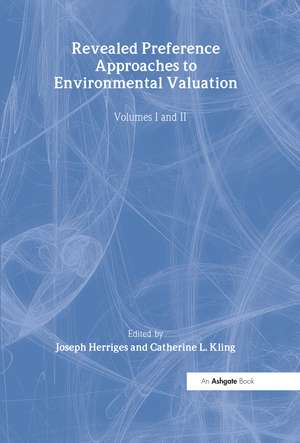Revealed Preference Approaches to Environmental Valuation Volumes I and II: The International Library of Environmental Economics and Policy
Autor Catherine L. Kling Editat de Joseph Herrigesen Limba Engleză Hardback – 19 iun 2008
Preț: 2281.46 lei
Preț vechi: 3049.14 lei
-25% Nou
Puncte Express: 3422
Preț estimativ în valută:
436.55€ • 457.02$ • 361.22£
436.55€ • 457.02$ • 361.22£
Comandă specială
Livrare economică 15-29 martie
Doresc să fiu notificat când acest titlu va fi disponibil:
Se trimite...
Preluare comenzi: 021 569.72.76
Specificații
ISBN-13: 9780754627142
ISBN-10: 0754627144
Pagini: 1218
Dimensiuni: 178 x 254 x 87 mm
Greutate: 2.79 kg
Ediția:1
Editura: Taylor & Francis
Colecția Routledge
Seria The International Library of Environmental Economics and Policy
Locul publicării:Oxford, United Kingdom
ISBN-10: 0754627144
Pagini: 1218
Dimensiuni: 178 x 254 x 87 mm
Greutate: 2.79 kg
Ediția:1
Editura: Taylor & Francis
Colecția Routledge
Seria The International Library of Environmental Economics and Policy
Locul publicării:Oxford, United Kingdom
Cuprins
Contents: Volume I: Introduction; Part I Recreation Demand: Theoretical Foundations: The effects of common sources of regression error on benefit estimates, Nancy E. Bockstael and Ivar E. Strand; The dual structure of incomplete demand systems, Jeffrey T. LaFrance and W. Michael Hanemann; Recovering weakly complementary preferences, Douglas M. Larson; Public goods as characteristics of non-market commodities, N.E. Bockstael and K.E. McConnell; A difficulty with travel cost method, Alan Randall; A diagrammatic exposition of weak complementarity and the Willig condition, V. Kerry Smith and H. Spencer Banzhaf; What's the use? Welfare estimates from revealed preference models when weak complementarity does not hold, Joseph A. Herriges, Catherine L. Kling and Daniel J. Phaneuf. Single Equation and Demand System Models: Estimating the value of water quality improvements in a recreational demand framework, Nancy E. Bockstael, W. Michael Hannemann and Catherine L. Kling; Estimating a system of recreation demand function using a seemingly unrelated Poisson regression approach, Teofilo Ozuna Jr and Irma Adriana Gomez; Count data models and the problem of zeros in recreation demand analysis, Timothy C. Haab and Kenneth E. McConnell; Modeling recreation demand in a Poisson system of equations: an analysis of the impact of international exchange rates, Jeffrey Englin, Peter Boxall and David Watson; 2 nested constant-elasticity-of-substitution models of recreational participation and site choice: an 'alternatives' model and an 'expenditures' model, Edward R. Morey, William S. Breffle and Pamela A. Greene. Random Utility Maximization (RUM) Models: A repeated nested-logit model of Atlantic salmon fishing, Edward R. Morey, Robert D. Rowe and Michael Watson; The implications of model specification for welfare estimation in nested logit models, Catherine L. Kling and Cynthia J. Thompson; Recreation demand models with taste differences over people, Kenneth E. Train; Nonlinear income effects in random utility models, Joseph A. Herriges and Catherine L. Kling; Inducing patterns of correlation and substitution in repeated logit models of recreation demand, Joseph A. Herriges and Daniel J. Phaneuf; Compensating variation and Hicksian choice probabilities in random utility models that are nonlinear in income, John K. Dagsvik and Anders Karlström; Handling unobserved site characteristics in random utility models of recreation demand, Jennifer Murdock. Corner Solution Models: Discrete/continuous models of consumer demand, W. Michael Hanemann; Searching for a model of multiple-site recreation demand that admits interior and boundary solutions, Edward R. Morey, Donald Waldman, Djeto Assane and Douglass Shaw; A dual approach to modeling corner solutions in recreation demand, Daniel J. Phaneuf; Estimation and welfare calculations in a generalized corner solution model with an application to recreation demand, Daniel J. Phaneuf, Catherine L. Kling and Joseph A. Herriges; Estimation and welfare analyses with large demand systems, Roger H. von Haefen, Daniel J. Phaneuf and George R. Parsons; Estimating preferences for outdoor recreation: a comparison of continuous and count data demand system frameworks, Roger H. von Haefen and Daniel J. Phaneuf. Defining the Choice Set: Site aggregation in a random utility model of recreation, George R. Parsons and Michael S. Needelman; Measuring recreation values with multiple-destination trips, Robert Mendelsohn, John Hof, George Peterson and Reed Johnson; Sampling and aggregation issues in random utility model estimation, Peter M. Feather; Using random utility models to estimate the recreational value of estuarine resources, Yoshiaki Kaoru, V. Kerry Smith and Jin Long Liu; Accounting for choice set endogeneity in random models of recreation demand, Timothy C. Haab and Robert L. Hicks; Spatial boundaries and choice set definition in a random utility model of recreation demand, George R. Parsons and A. Brett Hauber; Familiar and favorite sites in a random utility model of beach recreation, George R. Parsons, D. Matthew Massey and Ted Tomasi. Matters of Time: Measuring the cost of time in recreation demand analysis: an application to sportfishing, Kenneth E. McConnell and Ivar Strand; Time and the recreational demand model, Nancy E. Bockstael, Ivar E. Strand and W.Michael Hanemann; On-site time in the demand for recreation, K.E. McConnell; Habit formation and variety seeking in a discrete choice model of recreation demand, W.L. Adamowicz; An estimable dynamic model of recreation behavior with an application to great lakes angling, Bill Provencher and Richard C. Bishop; Estimating the cost of leisure time for recreation demand models, Peter Feather and W. Douglass Shaw; Household labor market choices and the demand for recreation, K.E. McConnell; Empirical specification requirements for 2-constraint models of recreation choice, Douglas M. Larson and Sabina L. Shaikh; Index. Volume II: Part II Hedonic Mod
Notă biografică
Joseph Herriges and Catherine L. Kling are both Professors in the Department of Economics at Iowa State University, USA.
Descriere
The articles and papers selected here represent the state of the art in the theory and application of revealed preference methods to value environmental amenities or contribute to development of the state of the art, or raise fundamental challenges and insights that drive the research agenda.







